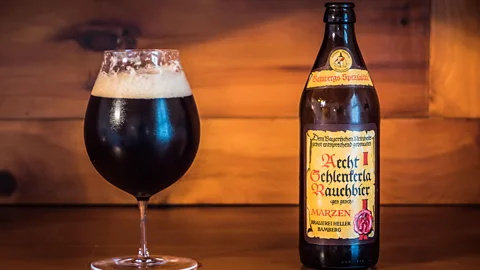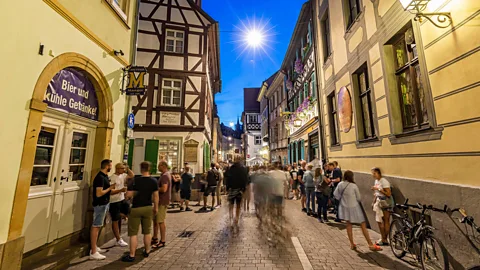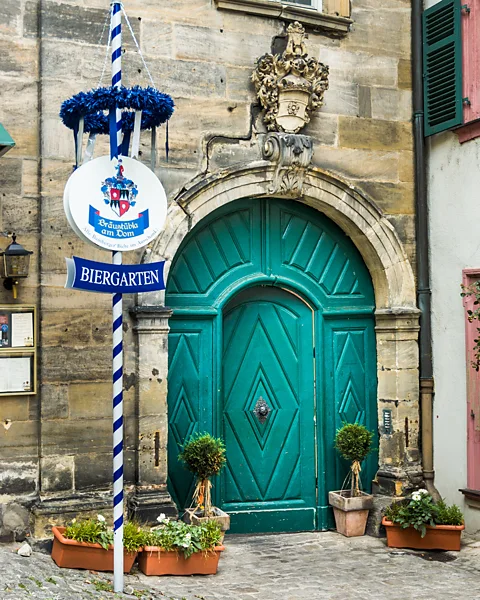Germany's sophisticated alternative to Oktoberfest
 Getty Images
Getty ImagesEvery September, millions of tourists flock to Munich for Oktoberfest. However, the true centre of German beer culture lies three hours north in the medieval town of Bamberg.
The first time I try Rauchbier (smoke beer) I am sitting in the dimly lit Schlenkerla – a 600-year-old tavern in the heart of Bamberg's old town. A toasty aroma fills the air as if seeping from the ancient wooden beams supporting the low ceiling. I swirl my first sip of the coffee-coloured liquid around in my mouth and my tastebuds explode with notes of slow-roasted ham. The flavour is unusual but palatable; it is like blue cheese, mushrooms or liquorice – either you set it aside after the first bite or feel compelled to keep going. Fortunately, I am in the latter group.
"According to an old proverb, you have to drink three Seidlas (half litre) to get used to the taste," says Matthias Trum, owner and brewmaster of Schlenkerla, whose family has run the tavern for six generations.
Rauchbier is the signature brew in a city with an unrivalled brewing tradition. While Munich is often thought of as the heart of German beer culture, with millions of tourists descending on the Bavarian capital every year for Oktoberfest, the true centre of German brewing lies in this Unesco-listed medieval town to 230km to the north. Bamberg is a sophisticated and relaxing alternative for beer enthusiasts who prefer quality and variety over sheer quantity.
Unlike its southern cousin, where six breweries control the production and distribution of beer in and around Munich, Bamberg is home to 10 family-owned breweries within the city centre and 174 in the surrounding Upper Franconia region, producing an estimated 2,500 different beers. With the highest density of breweries found anywhere on the globe, the region lays claim to the unofficial title of "Beer Capital of the World".
 Alamy
AlamyAccording to Trum, before the Industrial Revolution, every beer brewed in Northern Europe was a Rauchbier, the result of a malting process that involved drying green malt – barley that has been germinated but not yet dried – in a kiln heated by a beechwood fire. It was only after the first smokeless malt kiln was patented by Sir Nicholas Halse in England on 23 July 1635 that smokeless beers became the new standard and Rauchbier faded into obscurity.
While some craft breweries still produce smoke beer today, there are just two breweries in the world brewing it according to traditional methods with their own malting operations – Schlenkerla and Brauerei Spezial, another Bamberg brewery.
Why this tradition survived in Bamberg is unclear. One explanation is economic: the Industrial Revolution started much later in the Germanic states than in England so old brewing methods survived longer. The other is tinged with nostalgia.
The walls of Schlenkerla are adorned with sketched city maps and artwork collected by Trum's great-grandfather, Michael Graser, who ran the brewery in the early 20th Century and went to great lengths to maintain the tavern's 14th-Century aesthetic. The art collection, which depicts life in medieval Bamberg, speaks to a spirit of preservation that has been passed down through the generations and continues to influence brewing practices to this day.
"Our modern lifestyle goes hand-in-hand with mass production," Trum explains. "This makes our everyday products more affordable, but the result is a natural loss of diversity. It's really sad when flavour diversity is lost, which is why it's important to preserve old flavours."
 Alamy
AlamyIn 2017, Rauchbier was added to Slow Food's Ark of Taste, which aims to preserve and raise awareness of culinary traditions in danger of being lost in the modern world. In this spirit, Schlenkerla and Spezial have joined forces every year since 2021 – on 23 July, the day the smokeless kiln was patented – to celebrate Smoke Beer Preservation Day with a programme of events including brewery tours, beer tasting and a Rauchbier-inspired menu.
While Rauchbier is synonymous with Bamberg, the town's other breweries offer many more varieties and specialty brews to suit every taste. "Not everyone here likes Rauchbier," says local tour guide Christine Conrad, who invites me to try a delicious beer-filled truffle in Café am Dom. "Everyone has their favourite beer and brewery. We are very patriotic about our beer diversity; that's what sets Bamberg apart."
This diversity is the result of an exception to an ancient law. Across Europe, beer was historically brewed in monasteries and tied to land ownership. However, Bamberg's surrounding villages were not subjected to a so-called Meilenrecht ("mile right") – a law imposed by the city authorities that restricted brewing rights within a one-mile radius of the town to a privileged group of brewers – as strictly as in other parts of Europe. The reason for this is simple: they couldn't enforce it.
Due to Bamberg's location on busy medieval trade routes, beer consumption levels in the region were higher than elsewhere and brewers within the city were unable to cope with demand alone. This gave guesthouse owners in the surrounding areas leverage to ignore the Meilenrecht and sell their own beer. Over time, the number of such establishments grew, which explains to some degree the high density of family-owned breweries in the area and subsequent absence of larger, corporate breweries.
 Getty Images
Getty ImagesFor practical reasons, many of these breweries stored their beer in the seven hills surrounding Bamberg. Firstly, the narrow-cobbled streets of the old town were not suitable for transporting large quantities of beer and, more conveniently, early brewers discovered a network of tunnels in the hills created by sandstone quarrying in the Middle Ages. The cool temperatures of the Felsenkeller (rock cellars) were perfect for fermenting and storing beer.
Some of those breweries opened beer gardens on the hills directly above the rock cellars, giving rise to another unique quirk. In Bamberg, you don't go to the beer garden, you go auf den Kellern ("on the cellars"), meaning a leisurely afternoon spent drinking beer under the shade of chestnut trees has the added bonus of spectacular city views.
Tip:
Want to combine a festival atmosphere with Franconian beer diversity? The Sandkerwa Festival – a five-day folk festival in the streets of Bamberg's old town – is held every year from Thursday to Monday around 24 August.
It's deep in the chilled cellars of the Hellerbräu brewery on Stephansberg – one of the seven hills – that I get my second taste of Rauchbier. The taste is cleaner and more familiar this time, a combination of my taste buds adjusting and the fact that the beer has not yet fully matured.
"This one needs another week or two," says Martin Knab, a retired brewmaster who gives brewery tours in his spare time. As he walks me through the brewery, putting my limited knowledge of the chemical processes and temperatures to the test, I feel a new appreciation for the art of brewing. "Today we use computers and software to regulate everything according to our knowledge of modern biochemistry; back then, it was all intuition and experience," he said. Rather than rejecting modernity altogether, it's about preserving old traditions using modern methods.
More like this:
• The surprising wellness trend based on beer
• From Ancient Egypt to Roman Britain, brewers are reviving beers from the past
• Europe's under-the-radar region that's home to the 'undisputed tea world champions'
But not all breweries can afford this luxury. Many smaller, family-owned breweries are closing due to a declining interest in the craft. "Young people are less interested in continuing the family business; they don't want to help grandma roll dumplings every Saturday morning," says Nina Schipkowski, director of the Franconian Brewing Museum. "Another factor is that many brewers have to decide between brewing or gastronomy; they can no longer do both."
 Getty Images
Getty ImagesThe museum sits on another of Bamberg's hills, on the grounds of the St Michael's Monastery. It was once home to a Benedictine brewery founded in 1122, but in 1979 it was converted into a museum where visitors can learn about Franconian brewing traditions.
As I take a tour of through the museum's five levels, I study a map depicting all the breweries that have closed since the turn of the 20th Century – some due to casualties from two World Wars, others due to the effects of modernisation – and I reflect on all the beers and flavours that have been lost. That so many have survived against the odds is another testament to the strong brewing tradition that makes this region so unique.
The museum tour ends with a round of beer tasting, starting with a lighter Pils before finishing with a Rauchbier. As I savour my third glass, the new taste now as familiar as a Munich Helles, I am comforted by the thought that at least this unique flavour will survive.
--
If you liked this story, sign up for The Essential List newsletter – a handpicked selection of features, videos and can't-miss news, delivered to your inbox twice a week.
For more Travel stories from the BBC, follow us on Facebook, X and Instagram.
